Menu
-
Menuالعدمة
- Home
-
التصنيفات
-
-
التصنيفات
-
بذور الخضروات
-
أصناف حسب البلد
- أصناف من أرمينيا
- أصناف من البوسنة والهرسك
- أصناف من كرواتيا
- أصناف من فرنسا
- أصناف من ألمانيا
- أصناف من اليونان
- أصناف من المجر
- أصناف من الهند
- أصناف من إيطاليا
- أصناف من اليابان
- أصناف من شمال مقدونيا
- أصناف من بيرو
- أصناف من روسيا
- أصناف من صربيا
- أصناف من سلوفينيا
- أصناف من اسبانيا
- أصناف من تايلاند
- أصناف من تركيا
- أصناف من الولايات المتحدة الأمريكية
- بذور الطماطم
- بذور الذرة
- عائلة القرع
- الفول الأسرة
- بذور الخيار
- بذور الفلفل
- عائلة الجزرة
- عائلة البصل
- بذور الخس
- عائلة البطاطس
- عائلة الملفوف
- بذور الفجل
- عائلة الشمندر
- بذور البطيخ
- بذور بطيخ
- بذور القرنبيط
- عائلة عباد الشمس
-
أصناف حسب البلد
- بذور الفاكهة
- بذور الفلفل الحار
- بذور عشبة طبية
- تسلق بذور النباتات
- الأشجار - بذور بونساي
- بذور النخيل
- بذور الأعشاب الزينة
- بذور التبغ
-
بذور الخضروات
-
-
-
-
- منتجات جديدة
- التسليم - الدفع
- انشئ حساب
- FAQ
Last Product Reviews
These peppers came all the way from eastern Europe and took a while at no f...
By
 Fitim Berani on 21/09/2023
Fitim Berani on 21/09/2023
Verified Purchase
Last customers
- Stef, Waalwijk, Netherlands
- Dušan, KRAVANY NAD DUNAJOM, Slovakia
- Arno, Ehrenkirchen, Germany
- Costas, LARNACA , Cyprus
- Fulvio francesco, Santa Domenica Talao, Italy
- william, Dun, France
- Aymeric , Saint tricat, France
- Ricard, Sant Celoni, Spain
- Maureen, Enniscorthy Co Wexford , Ireland
- Paul, St. Vigil in Enneberg (BZ), Italy
- Ricardo jorge , Viseu , Portugal
- Radosav, Kragujevac, Serbia
- Sylvie, Neyruz, Switzerland
- Julien, Scionzier, France
- Zoran, Vinca, Serbia
- Josef, Hochdorf-Assenheim, Germany
- Davide, London, United Kingdom
- Kimberly, Victoria, Gozo, Malta
- Saša , Beograd, Serbia
- Ewa, Galway, Ireland
- Ioannis , Kato Achaia, Greece
- Samuele, Milano, Italy
- Dubravka, Niš , Serbia
- Theodoros, Grevena, Greece
- goderis, bredene, Belgium
- Vickie, SARONA, United States
- Maria, ÓBIDOS / LEIRIA, Portugal
- Emmanuel, Dijon, France
- Henri , Koumac, New Caledonia
- Manuel , Mülchi, Switzerland
يوجد 169 منتجا.
عرض 37-48 من 169 منتجات
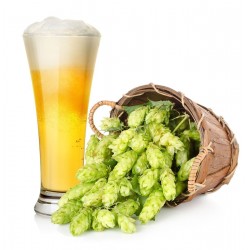
Beer Hops Seeds (Humulus...
السعر
1.85 €
SKU: MHS 62
Seeds Gallery Com,
5/
5
<!DOCTYPE html>
<html>
<head>
<meta http-equiv="Content-Type" content="text/html; charset=UTF-8" />
</head>
<body>
<h2><strong>Beer Hops Seeds (Humulus lupulus) Exotic</strong></h2>
<h2><span style="color: #ff0000;"><strong>Price for Package of 10 seeds.</strong></span></h2>
<p>People find hops exotic and sexy. Perhaps this is because of their close relationship to Cannabis. Aside from being used to flavor beer, Humulus lupulus (Hops) have a long history of herbal use among the Native Americans, mainly because of the soothing, sedative, tonic and calming effect on the body and the mind. Humulus lupulus contains asparagin, a diuretic; antibacterial agents humulone and lupulone; lupulin, a mild sedative/hypnotic. It is believed to be an aphrodisiac for men. Hop flowers were most often used as an infusion, but the flowers were also smoked. The fruit was applied externally as a poultice to ulcers, boils, swellings, etc. The female flowering heads were harvested in the autumn and used fresh or dried. The flowering heads are sprinkled with yellow translucent glands, which appear as a granular substance. Much of the hop's use as a flavoring and medicinal plant depends on the abundance of this powdery substance. The hop plant is a vine. It needs a similar structure for support as a grape plant. Even if you do not grow them for beer they make an excellent ornamental plant. Hardy in zones 4-9. Easy to grow!</p>
<h3><strong>Wikipedia:</strong></h3>
<p>Humulus lupulus (common hop or hop) is a species of flowering plant in the Cannabaceae family, native to Europe, western Asia and North America. It is a dioecious, perennial, herbaceous climbing plant which sends up new shoots in early spring and dies back to a cold-hardy rhizome in autumn. Strictly speaking it is a bine rather than a vine, using its own shoots to act as supports for new growth.</p>
<p> </p>
<p>H. lupulus is a main ingredient of many beers, and as such is widely cultivated for use by the brewing industry (for more information, see the main article on hops). The fragrant flower cones impart bitterness and flavor, and also have preservative qualities.[1] H. lupulus contains myrcene, humulene, xanthohumol, myrcenol, linalool, tannins, and resin.</p>
</body>
</html>
MHS 62


Variation från Serbien
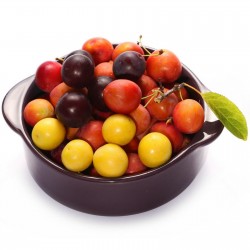
Cherry Plum Seeds (Prunus...
السعر
1.50 €
SKU: V 73
Seeds Gallery Com,
5/
5
<h2 class=""><strong>Cherry Plum Seeds (Prunus cerasifera)</strong></h2>
<h2><span style="color: #ff0000;"><strong>Price for Package of 10 Seeds.</strong></span></h2>
<p>Prunus cerasifera is a species of plum known by the common names cherry plum and myrobalan plum. It is native to Europe and Asia.</p>
<p>Wild types are large shrubs or small trees reaching 6-15 m tall, with deciduous leaves 4-6 cm long. It is one of the first European trees to flower in spring, often starting in mid-February. The flowers are white and about 2 cm across, with five petals. The fruit is a drupe, 2-3 cm in diameter, and yellow or red in colour. It is edible, and reaches maturity from early July to mid-September.</p>
<p><strong>Fruits</strong></p>
<p>This species can be found growing wild where it has escaped cultivation and become naturalized, such as in North America.</p>
<p>Cultivated cherry plums can have fruits, foliage, and flowers in any of several colors. Some varieties have sweet fruits that can be eaten fresh, while others are sour and better for making jam.</p>
<p>The cherry plum is a popular ornamental tree for garden and landscaping use, grown for its very early flowering. Numerous cultivars have been developed, many of them selected for purple foliage, such as 'Atropurpurea'. These purple-foliage forms (often called purple-leaf plum), also have dark purple fruit, which make an attractive, intensely coloured jam. They can have white or pink flowers. The cultivar 'Thundercloud' has bright red foliage which darkens purple.Others, such as 'Lindsayae', have green foliage. Some kinds of purple-leaf plums are used for bonsai and other forms of living sculpture.</p>
<div> </div>
<table border="1" cellspacing="0" cellpadding="0">
<tbody>
<tr>
<td colspan="2" valign="top" width="100%">
<p><span style="color: #008000;"><strong>Sowing Instructions</strong></span></p>
</td>
</tr>
<tr>
<td valign="top" nowrap="nowrap">
<p><span style="color: #008000;"><strong>Propagation:</strong></span></p>
</td>
<td valign="top">
<p><span style="color: #008000;">Seeds</span></p>
</td>
</tr>
<tr>
<td valign="top" nowrap="nowrap">
<p><span style="color: #008000;"><strong>Pretreat:</strong></span></p>
</td>
<td valign="top">
<p><span style="color: #008000;">soak in water for 24 hours</span></p>
</td>
</tr>
<tr>
<td valign="top" nowrap="nowrap">
<p><span style="color: #008000;"><strong>Stratification:</strong></span></p>
</td>
<td valign="top">
<p><span style="color: #008000;">0</span></p>
</td>
</tr>
<tr>
<td valign="top" nowrap="nowrap">
<p><span style="color: #008000;"><strong>Sowing Time:</strong></span></p>
</td>
<td valign="top">
<p><span style="color: #008000;">all year round </span></p>
</td>
</tr>
<tr>
<td valign="top" nowrap="nowrap">
<p><span style="color: #008000;"><strong>Sowing Depth:</strong></span></p>
</td>
<td valign="top">
<p><span style="color: #008000;">2-3 cm</span></p>
</td>
</tr>
<tr>
<td valign="top" nowrap="nowrap">
<p><span style="color: #008000;"><strong>Sowing Mix:</strong></span></p>
</td>
<td valign="top">
<p><span style="color: #008000;">Coir or sowing mix + sand or perlite</span></p>
</td>
</tr>
<tr>
<td valign="top" nowrap="nowrap">
<p><span style="color: #008000;"><strong>Germination temperature:</strong></span></p>
</td>
<td valign="top">
<p><span style="color: #008000;">25-28 ° C</span></p>
</td>
</tr>
<tr>
<td valign="top" nowrap="nowrap">
<p><span style="color: #008000;"><strong>Location:</strong></span></p>
</td>
<td valign="top">
<p><span style="color: #008000;">bright + keep constantly moist not wet</span></p>
</td>
</tr>
<tr>
<td valign="top" nowrap="nowrap">
<p><span style="color: #008000;"><strong>Germination Time:</strong></span></p>
</td>
<td valign="top">
<p><span style="color: #008000;">3-6 weeks</span></p>
</td>
</tr>
<tr>
<td valign="top" nowrap="nowrap">
<p><span style="color: #008000;"><strong>Watering:</strong></span></p>
</td>
<td valign="top">
<p><span style="color: #008000;">Water regularly during the growing season</span></p>
</td>
</tr>
<tr>
<td valign="top" nowrap="nowrap">
<p><span style="color: #008000;"><strong> </strong></span></p>
</td>
<td valign="top">
<p><br><span style="color: #008000;"><em>Copyright © 2012 Seeds Gallery - Saatgut Galerie - Galerija semena. </em><em>All Rights Reserved.</em></span></p>
</td>
</tr>
</tbody>
</table>
<script src="//cdn.public.n1ed.com/G3OMDFLT/widgets.js"></script>
V 73 (3g)

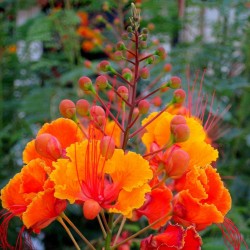
Pride of Barbados Seeds...
السعر
1.85 €
SKU: T 1
Seeds Gallery Com,
5/
5
<meta http-equiv="Content-Type" content="text/html; charset=UTF-8" />
<h2><span style="font-size: 14pt;"><strong>Pride of Barbados Seeds (Caesalpinia pulcherrima)</strong></span></h2>
<h2><span style="color: #ff0000; font-size: 14pt;"><strong>Price for Package of 5 seeds.</strong></span></h2>
<div>Caesalpinia pulcherrima-Desert Bird of Paradise-Also called Poinciana, Peacock flower, Mexican Bird of Paradise and Pride of Barbados. It can grow to 10 feet tall and is easily pruned to shape and size. Flowers have striking orange, red and yellow petals. It is found throughout tropical and sub-tropical America. It is used to attract hummingbirds. The seeds and other parts of the plant are poisonous if eaten. It thrives in zones 8 through 11. Mulch roots to protect through frosts. If frost causes damage prune back and it will come back next year. </div>
<table cellspacing="0" cellpadding="0" border="1">
<tbody>
<tr>
<td colspan="2" width="100%" valign="top">
<p><span style="color: #008000;"><strong>Sowing Instructions</strong></span></p>
</td>
</tr>
<tr>
<td valign="top" nowrap="nowrap">
<p><span style="color: #008000;"><strong>Propagation:</strong></span></p>
</td>
<td valign="top">
<p><span style="color: #008000;">Seeds</span></p>
</td>
</tr>
<tr>
<td valign="top" nowrap="nowrap">
<p><span style="color: #008000;"><strong>Pretreat:</strong></span></p>
</td>
<td valign="top">
<p><span style="color: #008000;">scarify / roughen, pour hot water over the seeds (no boiling water) + soak 24 h</span></p>
</td>
</tr>
<tr>
<td valign="top" nowrap="nowrap">
<p><span style="color: #008000;"><strong>Stratification:</strong></span></p>
</td>
<td valign="top">
<p><span style="color: #008000;">0</span></p>
</td>
</tr>
<tr>
<td valign="top" nowrap="nowrap">
<p><span style="color: #008000;"><strong>Sowing Time:</strong></span></p>
</td>
<td valign="top">
<p><span style="color: #008000;">all year round> preferred spring</span></p>
</td>
</tr>
<tr>
<td valign="top" nowrap="nowrap">
<p><span style="color: #008000;"><strong>Sowing Depth:</strong></span></p>
</td>
<td valign="top">
<p><span style="color: #008000;">1 cm</span></p>
</td>
</tr>
<tr>
<td valign="top" nowrap="nowrap">
<p><span style="color: #008000;"><strong>Sowing Mix:</strong></span></p>
</td>
<td valign="top">
<p><span style="color: #008000;">Coir or sowing mix + sand or perlite</span></p>
</td>
</tr>
<tr>
<td valign="top" nowrap="nowrap">
<p><span style="color: #008000;"><strong>Germination temperature:</strong></span></p>
</td>
<td valign="top">
<p><span style="color: #008000;">25 ° C </span></p>
</td>
</tr>
<tr>
<td valign="top" nowrap="nowrap">
<p><span style="color: #008000;"><strong>Location:</strong></span></p>
</td>
<td valign="top">
<p><span style="color: #008000;">bright + keep constantly moist not wet</span></p>
</td>
</tr>
<tr>
<td valign="top" nowrap="nowrap">
<p><span style="color: #008000;"><strong>Germination Time:</strong></span></p>
</td>
<td valign="top">
<p><span style="color: #008000;">2-4 weeks</span></p>
</td>
</tr>
<tr>
<td valign="top" nowrap="nowrap">
<p><span style="color: #008000;"><strong>Watering:</strong></span></p>
</td>
<td valign="top">
<p><span style="color: #008000;">Water regularly during the growing season</span></p>
</td>
</tr>
<tr>
<td valign="top" nowrap="nowrap">
<p><span style="color: #008000;"><strong> </strong></span></p>
</td>
<td valign="top">
<p><br /><span style="color: #008000;"><em>Copyright © 2012 Seeds Gallery - Saatgut Galerie - Galerija semena. </em><em>All Rights Reserved.</em><em></em></span></p>
<div><span style="color: #008000;"><em> </em></span></div>
</td>
</tr>
</tbody>
</table>
T 1 (5 S)


Denna anläggning är resistent mot vinter och frost. Se mer i beskrivningen.

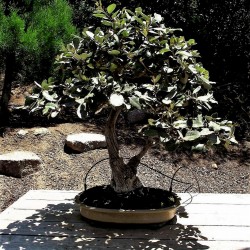
(Elaeagnus commutata)...
السعر
2.25 €
SKU: T 39 EC
Seeds Gallery Com,
5/
5
<!DOCTYPE html>
<html>
<head>
<meta http-equiv="Content-Type" content="text/html; charset=UTF-8" />
</head>
<body>
<h2><strong>(Elaeagnus commutata) Silverberry والبذور الذئب الصفصاف</strong></h2>
<h2><span style="color: #ff0000;"><strong>ثمن عبوة 5 بذور.</strong></span></h2>
<p>Elaeagnus commutata ، التوت الفضي أو صفصاف الذئب ، هو نوع من Elaeagnus موطنه أمريكا الغربية والشمالية ، من جنوب ألاسكا عبر كولومبيا البريطانية شرقًا إلى كيبيك ، جنوبًا إلى ولاية يوتا ، وعبر أقصى الغرب الأوسط للولايات المتحدة إلى ساوث داكوتا وغرب مينيسوتا. ينمو عادةً في التربة الرملية والحصوية الجافة إلى الرطبة في السهوب أو المروج أو حواف الغابات.</p>
<p>هذه النباتات عبارة عن شجيرات أو أشجار صغيرة يصل ارتفاعها إلى 1-4 أمتار. الأوراق واسعة ، طولها 2-7 سم ، فضية على كلا الجانبين مع قشور بيضاء صغيرة كثيفة. والزهور العطرة صفراء اللون ، ولها أربعة فصوص كورولا بطول 6-14 مم. الثمار عبارة عن حبيبات بيضاوية بطول 9-12 مم ومغطاة أيضًا بمقاييس فضية. لب الفاكهة دقيق الملمس ويحيط بالبذرة المفردة.</p>
<p>يزرع هذا النوع كنبات للزينة لأوراقه الفضية.</p>
<p>كل من ثمار وبذور هذا النبات صالحة للأكل مطبوخة أو نيئة. الثمرة قابضة جدًا ما لم تنضج تمامًا. تعتبر الفاكهة مصدرًا غنيًا جدًا بالفيتامينات والمعادن خاصةً أ ، ج ، هـ ، كما أنها مصدر جيد إلى حد ما للأحماض الدهنية الأساسية. نادرًا ما توجد هذه الدهون في الفاكهة. هذا النبات ، مثل البقوليات ، قادر على إصلاح النيتروجين. عندما تزرع في البساتين كنبات مصاحب ، فقد تم توثيق زيادة إنتاج الفاكهة بنسبة عشرة بالمائة. تقليديا ، يتم لف اللحاء الليفي لهذه الشجرة لصنع حبال قوية ونسجها في الملابس والبطانيات</p>
<p>الطيهوج حاد الذيل والطيور المغردة تأكل الفاكهة. هذا النبات هو مصدر غذاء للطيهوج حاد الذيل في الشتاء. يعتبر Silverberry غذاء مهم للحياة البرية ويوفر أكثر من ربع النظام الغذائي للموظ خلال فصل الشتاء في مونتانا. كما أنها توفر الغذاء للغزلان والأيائل. وهي توفر مواقع تغطية وتعشيش للأسماك والعديد من طيور الجاسرين في نورث داكوتا "في الأراضي العشبية الخشنة ، يزيد إنتاج العلف الفضي عند 1000 ساق لكل فدان."</p>
</body>
</html>
T 39 EC

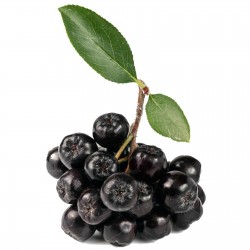
1000 بذور تشوكبيري (Aronia...
السعر
11.00 €
SKU: V 29 (4g)
Seeds Gallery Com,
5/
5
<h2><strong>1000 بذور تشوكبيري (Aronia melanocarpa)</strong></h2>
<h2><span style="color: #ff0000;"><strong>ثمن عبوة 1000 بذرة.</strong></span></h2>
<p>أَرُونِيَة أو الأرونيا هي فاكهة قريبة جدا من الفوتينيا والتي هي جنس نباتات تتكون من أشجار صغيرة ذات فروع كثيرة والتي أدرجت الأرونيا تحت تصنيفها في أغلب الأحيان. ولكن عالم النبات كوركليس كالكمان لاحظ أن هذا الجنس المهجن أو المدمج من النباتات يجب أن يدرج تحت اسم الأرونيا . هذا الجنس المدمج يحتوي تقريبا على خمس وستون نوعا يندرجون تحته.. وفي عام 2004 أبدى نفس العالم بعض الشكوك حول تركيبة الجزيئات لهذ الجنس من النباتات. في الشمال الشرقي لأمريكا هناك نوعان معروفان من هذه الفاكهة تمت تسميتهما بناءً على لونهما وهما التشوكبيري الأحمر والتشوكبيري الأسود بالإضافة إلى التشوكبيري البنفسجي الذي هو في الأصل هجين بين النوعين السابقين.</p>
<div>
<table border="1" cellspacing="0" cellpadding="0">
<tbody>
<tr>
<td colspan="2" valign="top" width="100%">
<p><span style="color: #008000;"><strong>Sowing Instructions</strong></span></p>
</td>
</tr>
<tr>
<td valign="top" nowrap="nowrap">
<p><span style="color: #008000;"><strong>Propagation:</strong></span></p>
</td>
<td valign="top">
<p><span style="color: #008000;">Seeds</span></p>
</td>
</tr>
<tr>
<td valign="top" nowrap="nowrap">
<p><span style="color: #008000;"><strong>Pretreat:</strong></span></p>
</td>
<td valign="top">
<p><span style="color: #008000;">soak in water for 8- 12 hours </span></p>
</td>
</tr>
<tr>
<td valign="top" nowrap="nowrap">
<p><span style="color: #008000;"><strong>Stratification:</strong></span></p>
</td>
<td valign="top">
<p><span style="color: #008000;">1 months in moist sowing mix at 2-5 ° C refrigerator</span></p>
</td>
</tr>
<tr>
<td valign="top" nowrap="nowrap">
<p><span style="color: #008000;"><strong>Sowing Time:</strong></span></p>
</td>
<td valign="top">
<p><span style="color: #008000;">all year round</span></p>
</td>
</tr>
<tr>
<td valign="top" nowrap="nowrap">
<p><span style="color: #008000;"><strong>Sowing Depth:</strong></span></p>
</td>
<td valign="top">
<p><span style="color: #008000;">1 cm</span></p>
</td>
</tr>
<tr>
<td valign="top" nowrap="nowrap">
<p><span style="color: #008000;"><strong>Sowing Mix:</strong></span></p>
</td>
<td valign="top">
<p><span style="color: #008000;">Coir or sowing mix + sand or perlite</span></p>
</td>
</tr>
<tr>
<td valign="top" nowrap="nowrap">
<p><span style="color: #008000;"><strong>Germination temperature:</strong></span></p>
</td>
<td valign="top">
<p><span style="color: #008000;">20 ° C</span></p>
</td>
</tr>
<tr>
<td valign="top" nowrap="nowrap">
<p><span style="color: #008000;"><strong>Location:</strong></span></p>
</td>
<td valign="top">
<p><span style="color: #008000;">bright + keep constantly moist not wet</span></p>
</td>
</tr>
<tr>
<td valign="top" nowrap="nowrap">
<p><span style="color: #008000;"><strong>Germination Time:</strong></span></p>
</td>
<td valign="top">
<p><span style="color: #008000;">2-8 weeks</span></p>
</td>
</tr>
<tr>
<td valign="top" nowrap="nowrap">
<p><span style="color: #008000;"><strong>Watering:</strong></span></p>
</td>
<td valign="top">
<p><span style="color: #008000;">Water regularly during the growing season</span></p>
</td>
</tr>
<tr>
<td valign="top" nowrap="nowrap">
<p><span style="color: #008000;"><strong> </strong></span></p>
</td>
<td valign="top">
<p><br><span style="color: #008000;"><em>Copyright © 2012 Seeds Gallery - Saatgut Galerie - Galerija semena. </em><em>All Rights Reserved.</em><em></em></span></p>
</td>
</tr>
</tbody>
</table>
</div>
<div>
<div style="text-align: center;">Genus: Aronia</div>
<div style="text-align: center;">Species: melanocarpa</div>
<div style="text-align: center;">Common Name: Black Chokeberry</div>
<div style="text-align: center;">Other Name: Chokeberry, Gueles Noires</div>
<div style="text-align: center;">Pre-treatment: required</div>
<div style="text-align: center;">Zone Hardiness Cold: 3</div>
<div style="text-align: center;">Zone Hardiness warm: 8</div>
<div style="text-align: center;">Plant Type: Small Shrub</div>
<div style="text-align: center;">Growth rate: medium</div>
<div style="text-align: center;">Vegetation type: deciduous</div>
<div style="text-align: center;">Leaf /Flower color: Green/White</div>
</div><script src="//cdn.public.n1ed.com/G3OMDFLT/widgets.js"></script>
V 29 (4g)

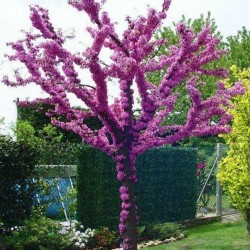
زمزريق أثيبي بذور
السعر
1.95 €
SKU: T 9
Seeds Gallery Com,
5/
5
<meta http-equiv="Content-Type" content="text/html; charset=UTF-8" />
<h2 id="short_description_content" class="rte align_justify"><strong>زمزريق أثيبي بذور</strong></h2>
<h2 class="rte align_justify"><span style="color: #ff0000;"><strong>ثمن العبوة المكونة من 10 ، 20 ، 50 بذرة.</strong></span></h2>
<p>الزمزريق الأثيبي (باللاتينية: Cercis siliquastrum) نوع نباتي شجري من جنس الزمزريق من الفصيلة البقولية.</p>
<p>The deep pink flowers are produced on year-old or older growth, including the trunk in late spring (cauliflory). The leaves appear shortly after the first flowers emerge. These are heart-shaped with a blunt apex, which occasionally has a shallow notch at the tip. The tree produces long flat pods that hang vertically. The flowers are edible and purportedly have a sweet-acid taste.</p>
<p>The species was first described by Linnaeus in 1753 and he gave it the specific epithet of siliquastrum which is derived from the Latin word siliqua, meaning "pod".[2] The generic name comes from the<span> </span>Greek<span> </span>kerkis, a "shuttle", which refers to the resemblance shown to this weaver's tool by the flat, woody seedpods.</p>
<p>There is a long-standing myth that Judas Iscariot hanged himself from a tree of this species. This belief is related to the common name "Judas Tree" which is possibly a corrupted derivation from the French common name, Arbre de Judée meaning tree of Judea, referring to the hilly regions of that country where the tree used to be common. Another possible source for the vernacular name is the fact that the flowers and seedpods can dangle direct from the trunk in a way reminiscent of Judas' suicide.</p>
<p>The flowers are pollinated by bees, attracted by nectar. Pollen from the protuding stamens is deposited on the bee's body and carried to another flower's stigma.</p>
<table cellspacing="5" cellpadding="0" border="0">
<tbody>
<tr>
<td class="biggreencontent" align="left"><span><strong>Cultivation details</strong></span></td>
<td></td>
</tr>
<tr>
<td colspan="2"><span>Succeeds in most soils and pH types, but dislikes growing in wet soils, especially when these are of clay. Prefers a deep sandy loam and a very sunny position. Thrives on chalk and in dry sandy soils. Probably does best on a poorish soil. Succeeds in light shade. Dislikes drought. Dormant plants are hardy to about -15°c. The young growth in spring, even on mature plants, is frost-tender and so it is best to grow the plants in a position sheltered from the early morning sun. Plants do not generally thrive at Kew, they prefer a hotter, continental climate in order to fully ripen their wood. One report says that plants require cool greenhouse treatment in Britain, though several good specimens have been seen outdoors in this country. The tree often does not flower freely in Britain, especially if the previous summer was cool. Plants are susceptible to coral spot fungus, especially when growing in areas with cool summers where the wood is not fully ripened. Plants in this genus are notably resistant to honey fungus. Resents root disturbance, plants should be planted into their permanent positions as soon as possible, preferably in May, and should be kept well watered until established. Any pruning is best carried out in the winter. A very ornamental plant, flowering well in Cornwall. It flowers better when growing in a continental climate. The flowers are produced on the branches of the previous or earlier years, and also on the trunk of the plant. A good bee plant. This species has a symbiotic relationship with certain soil bacteria, these bacteria form nodules on the roots and fix atmospheric nitrogen. Some of this nitrogen is utilized by the growing plant but some can also be used by other plants growing nearby.</span></td>
</tr>
</tbody>
</table>
T 9 (10 S)


Variation från Serbien
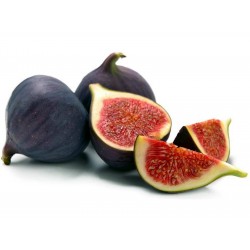
(Ficus carica) تين شائع بذور
السعر
1.95 €
SKU: V 19 CF
Seeds Gallery Com,
5/
5
<!DOCTYPE html>
<html>
<head>
<meta http-equiv="Content-Type" content="text/html; charset=UTF-8" />
</head>
<body>
<h2><strong>(Ficus carica) تين شائع بذور</strong></h2>
<h2><span style="color: #ff0000;"><strong>ثمن عبوة 100 (0.05 جم) بذور.</strong></span></h2>
<p>التين (باللاتينية: Ficus carica) من أشجار الفواكه الموسمية. يُزرع في غرب آسيا والشرق الأوسط لكن موطنه يمتد من تركيا حتى شمال الهند وهي منتشرة في بلدان البحر المتوسط، وقد وصلت جنوب ولاية كاليفورنيا عام 1759.</p>
<p>يزود التين جسم الإنسان بالفيتامينات والمعادن والألياف، وهي تحتوي على نسبة كبيرة من السكر والأملاح المعدنية الرئيسية، مثل الكالسيوم والفوسفور وفيتامين سي، ولها فوائد صحية مثل التخلص من حب الشباب والبثور والوقاية من الإمساك وارتفاع ضغط الدم والحماية من سرطان البروستات.</p>
<p>الموطن والتاريخ<br />التين من الثمار المشهورة والمفضلة عبر التاريخ. وهي فاكهة كان لها التقدير منذ قديم الزمان بشكله الجاف والغض الأخضر. ويزرع في عدة مناطق كفلسطين و فارس والعراق و سورياو الأردن ولبنان و ليبيا والسعودية وسلطنة عمان واليمن ولقد استعمله الفينيقيون في رحلاتهم البحرية والبرية. وحالياً فهو يزرع في كل حوض بلاد البحر المتوسط وفي معظم المناطق الدافئة والمعتدلة. ظهر التين في الرسومات والنقوش والمنحوتات التي اكتشفت في سوريا. ويقال بأنه وصل إلى الإغريق عبر بلد اسمها Caria في آسيا ومن هنا نعرف أن التسمية تحل اسم البلد التي وصل التين إلى الغرب منها وهو يسمى (بالإنجليزية: Ficus Caria). كان التين طعاماً رئيسياً عند الإغريق وقد استعمله بوفرة الاسبارطيون في موائد طعامهم اليومية. الرياضيون بشكل خاص اعتمد غذاءهم بشكل رئيسي على التين، لاعتقادهم بأنه يزيد في قوتهم. وقد سنّت الدولة الاغريقية في ذلك الوقت قانوناً يمنع تصدير التين والفاكهة ذات الصنف الممتاز من بلادهم إلى البلاد الأخرى. دخل التين أوروبا عبر إيطاليا. Pliny يعطي في كتاباته التفاصيل عن أكثر من 29 صنفاً من التين كانت معروفة في وقته. ويمتدح بشكل خاص الأنواع المنتجة في بلدة Tarant وبلد الموطن Caria و Herculaneum.</p>
<p>التين المجفف وجد في بومبي في حملات التنقيب التي أجريت على البلدة التي كانت مطمورة بالرمال (مدينة رومانية) وظهر التين في الرسوم الجدرانية التي ضمت التين إلى جانب مجموعات أخرى من الفاكهة. يذكر Pliny بأن التين المزروع في حدائق المنازل كان يستعمل لإطعام العبيد لكي يمدهم بالطاقة والقوة للخدمة، وبشكل خاص كان يتغذى على التين العمال والعبيد الزراعيون الذي يعملون بالزراعة. يلعب التين دوراً مهماً في الميثالوجيا اللاتينية أي علم الأساطير. وقد كان يقدم كقربان إلى الإله باخوس في الطقوس الدينية.</p>
<p>يقال إن الذئب الذي أرضع روملوس ورايموس (بالإنجليزية: Rumulus & Ramus) استراح تحت شجرة تين. وروملوس ورايموس هما مؤسسا الإمبراطورية الرومانية. ومن هنا كان لشجرة التين قدسية عند الرومان. ويذكر Ovid في كتاباته بأن خلال الاحتفالات السنوية لرأس السنة عند الرومان كان التين يقدم كهدية. وكان سكان بلدة Cyrene يضعون على رؤوسهم أكاليل من التين عندما كانوا يضحون إلى Saturn الذين كانوا يعتبرونه مكتشف الفاكهة وقد اشتهر التين أيام الرومان.</p>
<p>يذكر Pliny التين البري الذي كتب عنه هوميروس وغيره من المشاهير والأطباء مثل Dioscorides الذي اشتهر بكتاباته الطبية التي ترجمت إلى العربية. ووافق على بعض معلوماته مشاهير الأطباء العرب وانتقدها البعض الآخر ورفضوها وأثبتوا بالحجة والبراهين أسباب الرفض. وفي الإسلام كان قد ورد ذكره في القرآن.</p>
<p>حالياً يصدّر التين المجفف إلى العالم من آسيا ومن إسبانيا ومالطا وفرنسا. تجفف الثمار الناضجة تحت الشمس، أو تجفف في شكل رقائق عبر فتحتها وتعريض داخلها للشمس والهواء فيكون الجفاف أسرع وأفضل.</p>
<p>التكوين<br />- المركب الرئيسي الموجود بالتين هو سكر الديكستروز (بالإنجليزية: Dextrose) وهو يبلغ 50% من تركيبة التين - فيتامين A، B و C - يحتوي على نسب عالية من أملاح الحديد والكالسيوم والبوتاسيوم والنحاس - يعطي سعرات عالية. فكل 100 غرام تيناً أخضر يعطي 70سعرة، والجاف يعطي لنفس الوزن 270 سعرة</p>
<p>الاستعمالات والفوائد الطبية<br />- يستعمل التين كملين للطبيعة، ويستعمل مع غيره من الأدوية مثل مادة السنامكة (بالإنجليزية: Senna) والراوند (بالإنجليزية: Rhubarts) لتصنيع الشرابات الملينة خاصة في بريطانيا - مكرع ومجشئ يزيل النفخة والأرياح - ملطف للبشرة ينعمها ويزيل البثور. يدبغ الشعر الشايب موضعياً ومع الطعام - يزيل مشاكل الرشح والزكام وآثارهما على الأنف والحنجرة - تستعمل لبخات التين على خراجات الأسنان والتهابات اللثة والأورام بالفم وغيره - يستعمل الحليب الذي يخرج من عنق التين غير الناضج لإزالة الثآليل بأن يوضع الحليب على الثؤلول - منه البري والبستاني يمزج مع الشمر واليانسون والسمسم يؤكل صباحاً فيساعد الصحة على القوة والنشاط ويزيد في الوزن - يقوي الكبد وينشطه ويزيل تضخم الطحال - يعالج أمراض الدورة الدموية والأوردة خصوصاً البواسير، ويؤكل ويوضع موضعياً - ينشط الكلى ويزيد في الدورة الدموية التي تغذيها للقيام بوظائفها - يدر البول ويفتت الحصى والرمل - يعالج أمراض الصدر والسعال والربو وتشنج القصبات الهوائية والتهاباتها - يعالج أمراض تسرّع القلب. يمنع تجمع الماء في القلب والرئتين والجسم الذي ينتج عن ذلك بخفض الضغط بلطف، ويمنع النزيف - ينشط الدماغ والدورة الدموية فيه فيقوم الدماغ بوظائفه بطريقة أفضل خاصة إذا أكل مع المواد الغنية بالفوسفور مثل المكسرات واللوز والفستق الحلبي والصنوبر - يعالج أمراض الدورة الدموية بالدماغ مثل الفالج والرعاش والنشاف - يعالج أمراض الجلد مثل البهاق - يعالج امراض النقرس فيعمل على إخراج أملاح اليوريك أسيد من الجسم عن طريق البول وعن طريق التعرق. يعالج أمراض المفاصل وآلامها - حليب التين يساعد على تآكل اللحم الميت في الجسم مثل الثؤلول، فيوضع على اللحم القاسي فيصبح طرياً - يعالج التين الأمراض النفسية، ويعمل على تهدئة الأعصاب، وإزالة أنواع القلق والخوف والإحباط والتوتر، ويعتبر التين مصدر مهم لتقوية وتنشيط الطاقة الجنسية لدى الرجل والمرأة على غرار الفراولة والتوت البري الأزرق.</p>
<p>المعلومات الغذائية<br />تحتوي كل حبة تين كبيرة (64غ)، بحسب وزارة الزراعة الأميركية على المعلومات الغذائية التالية:</p>
<p>السعرات الحرارية: 47<br />الدهون: 0.19<br />الدهون المشبعة: 0<br />الكاربوهيدرات: 12.28<br />الألياف: 1.9<br />البروتينات: 0.48<br />الكولسترول: 0<br />شجرة التين الأسود<br />ثمار التين (بالإنجليزية: Figs -Ficus carica) مغذية وملينة ومضادة للسرطان وغنية بالبوتاسيوم ويضاف على البن ليكسبه نكهة وحلاوة وطعم السكر المحروق وغني بالكالسيوم وبه مادة (بالإنجليزية: Benzyaldehyde) تفيد في مقاومة السرطان.</p>
<p>يؤكل التين طازجا ويتم تجفيفه ليؤكل في الشتاء لكونه غني بالسكريات مما يعطي طاقة عالية. يجفف التين بعدة طرق منها طرق التقليدية ومنها الآلية الحديثة ففي سوريا يتم تجفيف التين تحت أشعة الشمس ثم يتم شك التين المجفف بحبال رفيعة من القنب على شكل قلائد طويلة كالمسابح.</p>
<p>شجرة التين من الأشجار المتساقطة الأوراق من جنس Ficus ومن هذا الجنس توجد أنواع كثيرة تستخدم كنبات زينة مستديمة الأوراق، وللتين قيمة غذائية عالية حيث تحتوي ثماره على كمية عالية من الكالسيوم والحديد بالإضافة للمواد الكربوهيدراتية التي توجد به بنسبة عالية.</p>
<p>الأصناف العالمية</p>
<p>الإنتاج<br />الأول- أدرياتيك الأبيض: حجم الصنف صغير، الثمار ذو لون أخضر فاتح واللب لونه أحمر فاتح والثمار يصلح للتجفيف بجودة متوسطة. الثاني- كونادريا: الشجرة أكبر قليلا من الصنف السابق والثمار حجمها أكبر أيضا لون الجلدة أخضر مصفر ولون اللحم أحمر خفيف تعطي الشجرة حوالي 30 إلى 40 ثمرة وتصلح للتجفيف. الثالث – بروجيتو: الشجرة متوسطة النمو والثمار لونها أحمر غامق ولون اللب وردي. نبات التين: يتراوح ارتفاع نبات التين من 3 – 10 متر ويتوقف هذا الارتفاع على توافر الشتاء الدافئ وكلما قلّت درجة الحرارة كان الجذع قصيرا وكثير التفريع، وتحتوي أجزاء الشجرة المختلفة على عصارة لبنية لاذعة وأوراق النبات سميكة جلدية ويختلف طول العنق وحجم الأوراق حسب الصنف وهي ورقة مفصصة لها شكل جميل.</p>
<p>الظروف البيئية المناسبة<br />شجرة التين تنمو في الأجواء ذات الشتاء الدفيء أي أنها لا تحتاج إلى شتاء بارد مثل باقي الفواكه المتساقطة الأوراق وفي الصيف يحتاج التين إلى جو ذي رطوبة معتدلة وسقوط الأمطار في الشتاء مع برودة الجو يسبب تشقق الثمار وتعفنها.</p>
<p>التربة المناسبة<br />معظم الأراضي تصلح لزراعة التين ولكن أفضلها لنموه هي الأراضي الطمية الصفراء، ويعتقد بأن الأراضي الغنية بالجير ضرورية جدا لإنتاج أفخر الأصناف وخصوصا تلك الصالحة للتجفيف وقد تتحمل نسبياً الجفاف والملوحة وبعض القلوية ولكن النمو سيكون ضعيفا.</p>
<p>تكاثر النبات<br />1-العقل<br />يتكاثر التين بالعقل الساقية حيث يتم استخدام العقل الناتجة من التقليم أو من المزارع القديمة على أن يراعى اختيارها نظيفة خالية من الأمراض، وتستطيع زرع العقل بشكل أفقي ويكون خشبها قصيرا والبراعم توجه للأعلى.</p>
<p>2-الترقيد<br />يستخدم عندما تكون الفروع قريبة من سطح التربة حتى يسهل ثنيها.</p>
<p>3-التكاثر بالسرطانات<br />تحضر بمكعبات خاصة للزراعة وتخزن في خنادق في وضع أفقي وتغطى بالتربة أو الرمل وتندى بالماء لحين زراعتها.</p>
</body>
</html>
V 19 CF (0,05g)

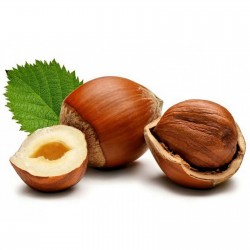
Hazelnut Seeds (Corylus...
السعر
1.55 €
SKU: V 107
Seeds Gallery Com,
5/
5
<div id="idTab1" class="rte">
<h2><strong>Hazelnut Seeds (Corylus avellana)</strong></h2>
<h2><span style="color: #ff0000;"><strong>Price for Package of 5 or 10 seeds.</strong></span></h2>
<p>A hazelnut is the nut of the hazel and is also known as cobnut or filbert nut according to species. A cob is roughly spherical to oval, about 15–25 mm long and 10–15 mm in diameter, with an outer fibrous husk surrounding a smooth shell. A filbert is more elongated, being about twice as long as it is round. The nut falls out of the husk when ripe, about seven to eight months after pollination. The kernel of the seed is edible and used raw or roasted, or ground into a paste. Hazelnuts are also used for livestock feed, as are chestnuts and acorns. The seed has a thin, dark brown skin, which is sometimes removed before cooking.</p>
<p>Hazelnuts are produced in commercial quantities in Turkey, Italy, Greece, Georgia, in south of the Spanish region of Catalonia, in the UK county of Kent and in the American states of Oregon and Washington. Turkey is the largest producer of hazelnuts in the world with approximately 75% of worldwide production.</p>
<p>Hazelnuts are used in confectionery to make praline, and also used in combination with chocolate for chocolate truffles and products such as Nutella and Frangelico liqueur. Hazelnut oil, pressed from hazelnuts, is strongly flavoured and used as a cooking oil.</p>
<p>Hazelnuts are rich in protein and unsaturated fat. Moreover, they contain significant amounts of thiamine and vitamin B6, as well as smaller amounts of other B vitamins.</p>
<p><strong>Historical cultivation</strong></p>
<p>In 1995, evidence of large-scale Mesolithic nut processing, some 9,000 years old, was found in a midden pit on the island of Colonsay in Scotland. The evidence consists of a large, shallow pit full of the remains of hundreds of thousands of burned hazelnut shells. Hazelnuts have been found on other Mesolithic sites, but rarely in such quantities or concentrated in one pit. The nuts were radiocarbon dated to 7720+/-110BP, which calibrates to circa 7000 BC. Similar sites in Britain are known only at Farnham in Surrey and Cass ny Hawin on the Isle of Man.[2][3] See also Sruwaddacon Bay, Kilcommon, Erris, County Mayo, Ireland.</p>
<p>This discovery gives an insight into communal activity and planning in the period. The nuts were harvested in a single year, and pollen analysis suggests the hazel trees were all cut down at the same time.[3] The scale of the activity, unparalleled elsewhere in Scotland, and the lack of large game on the island, suggest the possibility that Colonsay contained a community with a largely vegetarian diet for the time they spent on the island. The pit was originally on a beach close to the shore, and was associated with two smaller, stone-lined pits whose function remains obscure, a hearth, and a second cluster of pits.[2]</p>
<p>Because hazelnuts do not generally need to be toasted, indeed Kentish Cobnuts are still traditionally sold fresh, it has been speculated this was done to make them more digestible for children. Toasting the nuts was thought to increase how long they would keep, and they have historically been a useful food for mariners because they keep well.</p>
<p>Hazel has been grown historically in coppices for use in wattle and daub buildings, and in hedges. The Romans cultivated hazelnuts including in Britain, although there is no evidence that they spread specific cultivars. Cultivated varieties have been grown since at least the 16th century, with a great increase in varieties during the 1800s. In particular, the first really widespread cultivar, the Kentish Cobnut, was introduced in 1830.</p>
<p>The traditional method to increase nut production is called 'brutting', which involves prompting more of the trees' energy to go into flower bud production, by snapping but not breaking off the tips of the new year's shoots six or seven leaf groups from the join with the trunk or branch, at the end of the growing season. The traditional term for an area of cultivated hazelnuts is a plat.</p>
<p><strong>Modern cultivation</strong></p>
<p>The harvesting of hazelnuts is done either by hand or by manual or mechanical raking of fallen nuts. Common hazel is widely cultivated for its nuts, including in commercial orchards in Europe, Turkey, Iran and the Caucasus. The name "hazelnut" applies to the nuts of any of the species of the genus Corylus. This hazelnut, the kernel of the seed, is edible and used raw or roasted, or ground into a paste. The seed has a thin, dark brown skin, which has a bitter flavour and is sometimes removed before cooking.</p>
<p>The top producer of hazelnuts, by a large margin, is Turkey, specifically Ordu and Giresun Province. Turkish hazelnut production of 625,000 tonnes accounts for approximately 75% of worldwide production.[5]</p>
<p>In North America: in the United States, hazelnut production is concentrated in Oregon; they are also grown extensively just to the north, in the Fraser Valley of British Columbia, Canada. In 1996, the in-shell production in Oregon was about 19,900 tons (18,000 tonnes), compared to 100 tons (91 tonnes) in Washington. The hazelnut is growing in popularity in the U.S., where the Hazelnut Marketing Board was established in 1949 by Federal Hazelnut Marketing Order section 982.</p>
<p>Hazelnuts are also found in the Pangi Valley of Chamba district in India, where they are known as thangi.</p>
<p><strong>Cultivars</strong></p>
<p>The many cultivars of the hazel include: 'Barcelona', 'Butler', 'Casina', 'Clark' 'Cosford', 'Daviana', 'Delle Langhe', 'England', 'Ennis', 'Fillbert', 'Halls Giant', 'Jemtegaard', 'Kent Cob', 'Lewis', 'Tokolyi', 'Tonda Gentile', 'Tonda di Giffoni', 'Tonda Romana', 'Wanliss Pride', and 'Willamette'.[6] Some of these are grown for specific qualities of the nut; these qualities include large nut size and early- and late-fruiting cultivars, whereas others are grown as pollinators. The majority of commercial hazelnuts are propagated from root sprouts.[6] Some cultivars are of hybrid origin between common hazel and filbert.[7] One cultivar grown in Washington state, the 'DuChilly', has an elongated appearance, a thinner and less bitter skin, and a distinctly sweeter flavor than other varieties.</p>
<p><strong>Turkish hazelnut</strong></p>
<p>Turkish hazelnuts are not to be confused with the wild hazelnut of Turkey, Corylus colurna.</p>
<p><strong>Harvesting</strong></p>
<p>Hazelnuts are harvested annually in midautumn. As autumn comes to a close, the trees drop their nuts and leaves. Most commercial growers wait for the nuts to drop on their own, rather than use equipment to shake them from the tree.</p>
<p>Four primary pieces of equipment are used in commercial harvesting: the sweeper, the harvester, the nut cart and the forklift. The sweeper moves the nuts into the center of the rows, the harvester lifts and separates the nuts from any debris (i.e. twigs and leaves), the nut cart holds the nuts picked up by the harvester, and the forklift brings a tote to offload the nuts from the nut cart and then stacks the totes to be shipped to the processor (nut dryer). The sweeper is a low-to-the-ground machine that makes two passes in each tree row. It has a 2 m belt attached to the front that rotates to sweep leaves, nuts, and small twigs from left to right, depositing the material in the row's center as it drives forward. On the rear of the sweeper is a powerful blower to blow material left into the adjacent row with air speeds up to 90 m/s. Careful grooming during the year and patient blowing at harvest can eliminate the need for hand raking around the trunk of the tree, where nuts can accumulate. The sweeper prepares a single center row of nuts narrow enough for the harvesting tractor to drive over without driving on the center row. It is best to only sweep a few rows ahead of the harvesters at any given time, to prevent the tractor that drives the harvester from crushing the nuts that may still be falling from the trees. Hazelnut orchards may be harvested up to three times during the harvest season, depending on the quantity of nuts in the trees and the rate of nut drop as a result of weather.</p>
<p>The harvester is a slow-moving machine pulled by a tractor, which lifts the material off the ground and separates the nuts from the leaves, empty husks, and twigs. As the harvester drives over the rows, a rotating cylinder with hundreds of tines rakes the material onto a belt. The belt takes the material over a blower and under a powerful vacuum that sucks the lightweight dirt and leaves from the nuts, and discharges it into the orchard. The remaining nuts are conveyed into a nut cart pulled behind the harvester. Once a tote is filled with nuts, the forklift will haul away the full totes and bring empties back to the harvester to maximize the harvester's time.</p>
<p>Two different timing strategies are used for collecting the fallen nuts. The first is to harvest early when approximately half of the nuts have fallen. With less material on the ground, the harvester can work faster with less chance of a breakdown. The second option is to wait for all the nuts to fall before harvesting. Though the first option is considered the better of the two,[10] two or three passes do take more time to complete than one. Weather must also be a consideration. Rain inhibits harvest and should a farmer wait for all the nuts to fall after a rainy season, it becomes much more difficult to harvest. Pickup also varies with how many acres are being farmed and the number of sweepers, harvesters, nut carts and forklifts available.</p>
<p>A dry orchard can be dusty, so equipment operators should wear breathing protection. Conversely, if it is too wet, mud cakes in the machinery and moisture weighs down the material, making it impossible for the equipment to function without picking up large quantities of mud.</p>
<p><strong>Culinary uses</strong></p>
<p>Hazelnuts are used in confectionery to make some pralines, in chocolate for some chocolate truffles, and in hazelnut paste products. In Austria (especially Vienna), hazelnut paste is an ingredient in the making of tortes (such as Viennese hazelnut torte) which are famous there. In Kiev cake, hazelnut flour is used to flavor its meringue body, and crushed hazelnuts are sprinkled over its sides. Dacquoise, a French dessert cake, often contains a layer of hazelnut meringue. Hazelnut is a primary ingredient of the vodka-based liqueur frangelico. Hazelnuts are used abundantly in Turkish cuisine especially on the Pontic coast of Anatolia. In Georgian cuisine, traditional snack churchkhela and sauce satsivi are often cooked with hazelnuts (along with walnuts).[11]</p>
<p>Hazelnut-flavoured coffee seems (to many users) to be slightly sweetened and less acidic, though the nut is low in natural saccharides.[citation needed] The reason for such perception is not yet understood.</p>
<p>Over 2,000 tonnes are imported annually into Australia, mostly to supply the demand from the Cadbury-Schweppes company. Hazelnut oil pressed from hazelnuts is strongly flavoured and used as a cooking oil.</p>
<p>Common hazel plants are eaten by these species of Lepidoptera.</p>
<p><strong>Health benefits</strong></p>
<p>Hazelnuts have a significant place among the types of dried nuts in terms of nutrition and health because of the composition of fats (primarily oleic acid), protein, carbohydrates, vitamins (vitamin E), minerals, dietary fibers, phytosterol (beta-sitosterol), and antioxidant phenolics[13] such as flavan-3-ols.</p>
</div><script src="//cdn.public.n1ed.com/G3OMDFLT/widgets.js"></script>
V 107 (5 NS)


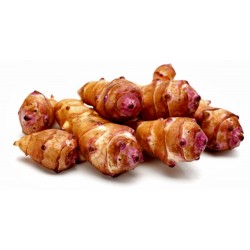
Jerusalem Artichoke Tubers...
السعر
7.95 €
SKU: P 421
Seeds Gallery Com,
5/
5
<!DOCTYPE html>
<html>
<head>
<meta http-equiv="Content-Type" content="text/html; charset=UTF-8" />
</head>
<body>
<h2><span style="text-decoration: underline;"><strong><em>Jerusalem Artichoke Tubers (Helianthus tuberosus)</em></strong></span></h2>
<h3><span style="color: #f30303;"><strong>Price for package of 5 Tubers.</strong></span></h3>
<p><i>Helianthus tuberosus</i> is a herbaceous perennial plant growing to 1.5–3 m (4 ft 11 in–9 ft 10 in) tall with opposite leaves on the upper part of the stem but alternate below.<sup id="cite_ref-4" class="reference">[4]</sup> The leaves have a rough, hairy texture. Larger leaves on the lower stem are broad ovoid-acute and can be up to 30 cm (12 in) long. Leaves higher on the stem are smaller and narrower.</p>
<p>The flowers are yellow and produced in capitate flowerheads, which are 5–10 cm (2.0–3.9 in) in diameter, with 10–20 ray florets and 60 or more small disc florets.<sup id="cite_ref-lilly_5-1" class="reference">[5]</sup></p>
<p>The tubers are elongated and uneven, typically 7.5–10 cm (3.0–3.9 in) long and 3–5 cm (1.2–2.0 in) thick, and vaguely resembling ginger root in appearance, with a crisp texture when raw. They vary in colour from pale brown to white, red, or purple.<sup id="cite_ref-purdue_3-1" class="reference">[3]</sup><sup id="cite_ref-rhs_6-0" class="reference">[6]</sup></p>
<h2><span class="mw-headline" id="Food_use">Food use</span></h2>
<p>Before the arrival of Europeans, Native Americans cultivated <i>H. tuberosus</i> as a food source. The tubers persist for years after being planted, so that the species expanded its range from central North America to the eastern and western regions.<sup class="noprint Inline-Template Template-Fact">[<i><span title="This claim needs references to reliable sources. (September 2017)">citation needed</span></i>]</sup> Early European colonists learned of this, and sent tubers back to Europe, where it became a popular crop and naturalized there. It later gradually fell into obscurity in North America, but attempts to market it commercially have been successful in the late 1900s and early 2000s.<sup id="cite_ref-lilly_5-2" class="reference">[5]</sup><sup id="cite_ref-LevetinEstelle_7-0" class="reference">[7]</sup></p>
<p>The sunchoke contains about 2% protein, no oil, and little starch. It is rich in the carbohydrate inulin (76%), which is a polymer of the monosaccharide fructose. Tubers stored for any length of time convert their inulin into its component fructose. Jerusalem artichokes have an underlying sweet taste because of the fructose, which is about one and a half times as sweet as sucrose.<sup id="cite_ref-LevetinEstelle_7-1" class="reference">[7]</sup></p>
<p>It has also been reported as a folk remedy for diabetes.<sup id="cite_ref-LevetinEstelle_7-2" class="reference">[7]</sup> Temperature variances have been shown to affect the amount of inulin the Jerusalem artichoke can produce. When not in tropical regions, it makes less inulin than when it is in a warmer region.<sup id="cite_ref-8" class="reference">[8]</sup></p>
<h2><span class="mw-headline" id="Etymology">Etymology</span></h2>
<div class="thumb tleft">
<div class="thumbinner"><img alt="" src="https://upload.wikimedia.org/wikipedia/commons/thumb/c/c2/Sunroot_flowers.jpg/220px-Sunroot_flowers.jpg" class="thumbimage" width="220" height="165" />
<div class="thumbcaption">
<div class="magnify"></div>
Jerusalem artichoke flowers</div>
</div>
</div>
<p>Despite one of its names, the Jerusalem artichoke has no relationship to Jerusalem, and it is not a type of artichoke, though the two are distantly related as members of the daisy family. The origin of the "Jerusalem" part of the name is uncertain. Italian settlers in the United States called the plant <i>girasole</i>, the Italian word for sunflower, because of its familial relationship to the garden sunflower (both plants are members of the genus <i>Helianthus</i>). Over time, the name <i>girasole</i> (pronounced closer to <span title="Representation in the International Phonetic Alphabet (IPA)" class="IPA">[d͡ʒiraˈzu:l]</span> in southern Italian dialects) may have been changed to Jerusalem.<sup id="cite_ref-Smith_1807_9-0" class="reference">[9]</sup> In other words, English speakers would have corrupted "girasole artichoke" (meaning, "sunflower artichoke") to Jerusalem artichoke. Another explanation for the name is that the Puritans, when they came to the New World, named the plant with regard to the "New Jerusalem" they believed they were creating in the wilderness.<sup id="cite_ref-LevetinEstelle_7-3" class="reference">[7]</sup> Also, various other names have been applied to the plant, such as the French or Canada potato, <i>topinambour</i>, and lambchoke. Sunchoke, a name by which it is still known today, was invented in the 1960s by Frieda Caplan, a produce wholesaler who was trying to revive the plant's appeal.<sup id="cite_ref-LevetinEstelle_7-4" class="reference">[7]</sup></p>
<p>The artichoke part of the Jerusalem artichoke's name comes from the taste of its edible tuber. Samuel de Champlain, the French explorer, sent the first samples of the plant to France, noting its taste was similar to that of an artichoke.<sup id="cite_ref-10" class="reference">[10]</sup> <sup id="cite_ref-11" class="reference">[11]</sup></p>
<p>The name <i>topinambur</i>, in one account, dates from 1615, when a member of the Brazilian coastal tribe called the Tupinambá visited the Vatican at the same time that a sample of the tuber from Canada was on display there, presented as a critical food source that helped French Canadian settlers survive the winter. The New World connection resulted in the name <i>topinambur</i> being applied to the tuber, the word now used in French, German, Italian, Romanian, Russian, and Spanish.<sup id="cite_ref-12" class="reference">[12]</sup> <sup id="cite_ref-13" class="reference">[13]</sup></p>
<h2><span class="mw-headline" id="History">History</span></h2>
<p>Jerusalem artichokes were first cultivated by the Native Americans long before the arrival of the Europeans; this extensive cultivation obscures the exact native range of the species.<sup id="cite_ref-grin_2-1" class="reference">[2]</sup> The French explorer Samuel de Champlain discovered that the Native people of Nauset Harbor in Massachusetts had cultivated roots that tasted like artichoke. The following year, Champlain returned to the same area to discover that the roots had a flavour similar to chard<sup id="cite_ref-NathalieCooke_14-0" class="reference">[14]</sup> and was responsible for bringing the plant back to France. Some time later, Petrus Hondius, a Dutch botanist planted a shrivelled Jerusalem artichoke tuber in his garden at Terneuzen and was surprised to see the plant proliferate.<sup id="cite_ref-NathalieCooke_14-1" class="reference">[14]</sup> Jerusalem artichokes are so well suited for the European climate and soil that the plant multiplies quickly. By the mid-1600s, the Jerusalem artichoke had become a very common vegetable for human consumption in Europe and the Americas and was also used for livestock feed in Europe and colonial America.<sup id="cite_ref-LevetinEstelle_7-5" class="reference">[7]</sup> The French in particular were especially fond of the vegetable, which reached its peak popularity at the turn of the 19th century.<sup id="cite_ref-LevetinEstelle_7-6" class="reference">[7]</sup> The Jerusalem artichoke was titled 'best soup vegetable' in the 2002 Nice Festival for the Heritage of the French Cuisine.</p>
<p>The French explorer and Acadia’s first historian, Marc Lescarbot, described Jerusalem artichokes as being “as big as turnips or truffles”, suitable for eating and taste "like chards, but more pleasant.” In 1629, English herbalist and botanist, John Parkinson, wrote that the widely grown Jerusalem artichoke had become very common and cheap in London, so much so “that even the most vulgar begin to despise them.” In contrast, when Jerusalem artichokes first arrived in England, the tubers were "dainties for the Queen".<sup id="cite_ref-NathalieCooke_14-2" class="reference">[14]</sup></p>
<p>They have also been called the "Canadian truffle". In France, they are associated, along with rutabagas, with the deprivations of the years of Nazi occupation during World War II, where the rationing and scarcity of traditional foods made them a regular part of the French diet until at the end of the war, they returned to their customary role as animal feed.<sup id="cite_ref-15" class="reference">[15]</sup></p>
<h2><span class="mw-headline" id="Cultivation_and_use">Cultivation and use</span></h2>
<div class="thumb tleft">
<div class="thumbinner"><img alt="" src="https://upload.wikimedia.org/wikipedia/commons/thumb/4/45/Sunroot_growing.jpg/220px-Sunroot_growing.jpg" class="thumbimage" width="220" height="244" />
<div class="thumbcaption">
<div class="magnify"></div>
Young plants in a garden</div>
</div>
</div>
<div class="thumb tright">
<div class="thumbinner"><img alt="" src="https://upload.wikimedia.org/wikipedia/commons/thumb/e/e5/Topinambur_H2ase1.jpg/220px-Topinambur_H2ase1.jpg" class="thumbimage" width="220" height="165" />
<div class="thumbcaption">
<div class="magnify"></div>
Sunroot tubers</div>
</div>
</div>
<p>Unlike most tubers, but in common with many other members of the Asteraceae (including the artichoke), the tubers store their carbohydrate as inulin (not to be confused with insulin) rather than as starch. So, Jerusalem artichoke tubers are an important source of inulin used as a dietary fiber in food manufacturing.<sup id="cite_ref-16" class="reference">[16]</sup></p>
<p>Crop yields are high, typically 16–20 tonnes/ha for tubers, and 18–28 tonnes/ha green weight for foliage. Jerusalem artichoke also has potential for production of ethanol fuel, using inulin-adapted strains of yeast for fermentation.<sup id="cite_ref-purdue_3-2" class="reference">[3]</sup></p>
<p>Jerusalem artichokes are easy to cultivate, which tempts gardeners to simply leave them completely alone to grow. The quality of the edible tubers degrades, however, unless the plants are dug up and replanted in fertile soil. Because even a small piece of tuber will grow if left in the ground, the plant can ruin gardens by smothering or overshadowing nearby plants and can take over huge areas. Farmers growing Jerusalem artichokes who then rotate the crop may have to treat the field with a weedkiller (such as glyphosate) to stop their spread. Each root can make an additional 75 to 200 tubers during a year.</p>
<p>The tubers are sometimes used as a substitute for potatoes:<sup id="cite_ref-17" class="reference">[17]</sup> they have a similar consistency, and in their raw form have a similar texture, but a sweeter, nuttier flavor; raw and sliced thinly, they are fit for a salad. Their inulin form of carbohydrates give the tubers a tendency to become soft and mushy if boiled, but they retain their texture better when steamed. The inulin cannot be broken down by the human digestive system<sup id="cite_ref-18" class="reference">[18]</sup> but it is metabolized by bacteria in the colon. This can cause flatulence and, in some cases, gastric pain. <i>Gerard's Herbal</i>, printed in 1621, quotes the English botanist John Goodyer on Jerusalem artichokes:<sup id="cite_ref-19" class="reference">[19]</sup></p>
<blockquote class="templatequote">
<p>which way soever they be dressed and eaten, they stir and cause a filthy loathsome stinking wind within the body, thereby causing the belly to be pained and tormented, and are a meat more fit for swine than men.</p>
</blockquote>
<p>Jerusalem artichokes have 650 mg potassium per 1 cup (150g) serving. They are also high in iron, and contain 10-12% of the US RDA of fiber, niacin, thiamine, phosphorus, and copper.<sup id="cite_ref-20" class="reference">[20]</sup></p>
<p>Jerusalem artichokes can be used as animal feed, but they must be washed before being fed to most animals. Pigs can forage, however, and safely eat them directly from the ground. The stalks and leaves can be harvested and used for silage, though cutting the tops greatly reduces the harvest of the roots.</p>
<table class="infobox nowrap"><caption>Jerusalem-artichokes, raw</caption>
<tbody>
<tr>
<th colspan="2">Nutritional value per 100 g (3.5 oz)</th>
</tr>
<tr>
<th scope="row">Energy</th>
<td>304 kJ (73 kcal)</td>
</tr>
<tr>
<td colspan="2"></td>
</tr>
<tr>
<th scope="row">
<div><b>Carbohydrates</b></div>
</th>
<td>
<div>17.44 g</div>
</td>
</tr>
<tr>
<th scope="row">Sugars</th>
<td>9.6 g</td>
</tr>
<tr>
<th scope="row">Dietary fiber</th>
<td>1.6 g</td>
</tr>
<tr>
<td colspan="2"></td>
</tr>
<tr>
<th scope="row">
<div><b>Fat</b></div>
</th>
<td>
<div>0.01 g</div>
</td>
</tr>
<tr>
<td colspan="2"></td>
</tr>
<tr>
<th scope="row">
<div><b>Protein</b></div>
</th>
<td>
<div>2 g</div>
</td>
</tr>
<tr>
<td colspan="2"></td>
</tr>
<tr>
<th colspan="2">Vitamins</th>
</tr>
<tr>
<th scope="row">Thiamine <span>(B<span><span>1</span></span>)</span></th>
<td>
<div>(17%)</div>
0.2 mg</td>
</tr>
<tr>
<th scope="row">Riboflavin <span>(B<span><span>2</span></span>)</span></th>
<td>
<div>(5%)</div>
0.06 mg</td>
</tr>
<tr>
<th scope="row">Niacin <span>(B<span><span>3</span></span>)</span></th>
<td>
<div>(9%)</div>
1.3 mg</td>
</tr>
<tr>
<th scope="row">Pantothenic acid <span>(B<span><span>5</span></span>)</span></th>
<td>
<div>(8%)</div>
0.397 mg</td>
</tr>
<tr>
<th scope="row">Vitamin B<span><span>6</span></span></th>
<td>
<div>(6%)</div>
0.077 mg</td>
</tr>
<tr>
<th scope="row">Folate <span>(B<span><span>9</span></span>)</span></th>
<td>
<div>(3%)</div>
13 μg</td>
</tr>
<tr>
<th scope="row">Vitamin C</th>
<td>
<div>(5%)</div>
4 mg</td>
</tr>
<tr>
<td colspan="2"></td>
</tr>
<tr>
<th colspan="2">Minerals</th>
</tr>
<tr>
<th scope="row">Calcium</th>
<td>
<div>(1%)</div>
14 mg</td>
</tr>
<tr>
<th scope="row">Iron</th>
<td>
<div>(26%)</div>
3.4 mg</td>
</tr>
<tr>
<th scope="row">Magnesium</th>
<td>
<div>(5%)</div>
17 mg</td>
</tr>
<tr>
<th scope="row">Phosphorus</th>
<td>
<div>(11%)</div>
78 mg</td>
</tr>
<tr>
<th scope="row">Potassium</th>
<td>
<div>(9%)</div>
429 mg</td>
</tr>
<tr>
<td colspan="2"><hr />
<div class="wrap">Link to USDA Database entry</div>
</td>
</tr>
<tr>
<td colspan="2">
<div class="plainlist">
<ul>
<li>Units</li>
<li>μg = micrograms • mg = milligrams</li>
<li>IU = International units</li>
</ul>
</div>
</td>
</tr>
<tr>
<td colspan="2" class="wrap">Percentages are roughly approximated using US recommendations for adults.<br /><span class="nowrap"><span>Source: USDA Nutrient Database</span></span></td>
</tr>
</tbody>
</table>
<h3><span class="mw-headline" id="Fermented_products">Fermented products</span></h3>
<p>In Baden-Württemberg, Germany, over 90% of the Jerusalem artichoke crop is used to produce a spirit called "Topinambur<span class="noprint"> (de)</span>", "Topi" or "Rossler".<sup id="cite_ref-21" class="reference">[21]</sup> By the end of the 19th-century, Jerusalem artichokes were being used in Baden to make a spirit called "Jerusalem Artichoke Brandy", "Jerusalem Artichoke", "Topi", "Erdäpfler", "Rossler", or "Borbel".</p>
<p>Jerusalem artichoke brandy smells fruity and has a slight nutty-sweet flavour. It is characterised by an intense, pleasing, earthy note. The tubers are washed and dried in an oven before being fermented and distilled. It can be further refined to make "Red Rossler" by adding common tormentil, and other ingredients such as currants, to produce a somewhat bitter and astringent decoction. It is used as digestif, as well as a remedy for diarrhoea or abdominal pain.</p>
<h2><span class="mw-headline" id="Marketing_scheme">Marketing scheme</span></h2>
<p>In the 1980s, the Jerusalem artichoke also gained some notoriety when its seeds were planted by Midwestern US farmers at the prodding of an agricultural attempt to save the family farm. This effort was an attempt to teach independent farmers to raise their own food, feed, and fuel. Little market existed for the tuber in that part of the US at the time, but contacts were made with sugar producers, oil and gas companies, and the fresh food market for markets to be developed. Fructose had not yet been established as a mainstay, nor was ethanol used as a main fuel additive as it is today. The only real profits then in this effort were realized by a few first-year growers (who sold some of their seed to other farmers individually as well as with the help of the company attempting this venture). As a result, many of the farmers who had planted large quantities of the crop lost money.</p>
</body>
</html>
P 421


Denna anläggning är resistent mot vinter och frost. Se mer i beskrivningen.
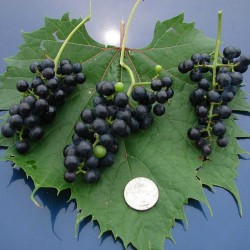
بذور العنب البري (Vitis spp.)
السعر
1.55 €
SKU: V 131 WG
Seeds Gallery Com,
5/
5
<meta http-equiv="Content-Type" content="text/html; charset=UTF-8" />
<h2><strong>بذور العنب البري (Vitis spp.)</strong></h2>
<h2><span style="color: #ff0000;"><strong>ثمن حزمة من 10 بذور.</strong></span></h2>
<p>تم العثور على العنب البري (Vitis spp.) من قبل المستوطنين الأوروبيين عندما وصلوا إلى الساحل الشرقي لما يعرف الآن بالولايات المتحدة. اعتاد العنب المستأنس (Vitis vinifera) الأصلي في أوروبا ، فقد شجعت الكروم والفواكه المتفشية من العنب البري خبراء العنب على تهجين الأنواع المختلفة لإنتاج فواكه أكبر وأكثر حلاوة للنبيذ والعصير والهلام. في حين تم زراعة عدد قليل من العنب البري المحلي ، فإن معظم العنب المستأنس من أصناف vinifera.</p>
<p>الاختلافات الرئيسية بين العنب البري والمزروع هي حجم وحلاوة الثمار ، ومقاومة الآفات والأمراض ، والتكاثر. بشكل عام ، يميل العنب البري إلى الحصول على ثمار أصغر من العنب المستأنس.</p>
<p>إنها تنمو بسهولة وهي أقل تقييدًا بالأمراض والآفات من أصناف العنب المزروعة ، مما يجعلها مزارع غزيرة الإنتاج. سبب آخر لتصنيفها كأعشاب عنب برية.</p>
<p>ينتج العنب البري ثمارًا يتراوح قطرها من 1/8 إلى 1 بوصة. في حين أن الثمار صالحة للأكل ، إلا أنها تختلف من حامضية إلى حلوة (البذور التي نقدمها من العنب البري ، هي الثمار حلوة جدًا).</p>
<p>هل العنب البري صالح للأكل؟<br />نعم ، العنب البري صالح للأكل</p>
<p>يعتبر العنب البري رائعًا للعصر ويتم تجميده جيدًا إذا لم يكن لديك الوقت أو الرغبة في العصير على الفور. العصير يصنع جيلي ممتاز. يمكن طهيها في أطباق والأوراق صالحة للأكل أيضًا. تُعرف الأوراق باسم "دولما" منذ فترة طويلة في مطبخ البحر الأبيض المتوسط ، محشوة بالأرز واللحم والتوابل المختلفة.</p>
V 131 WG 10 S

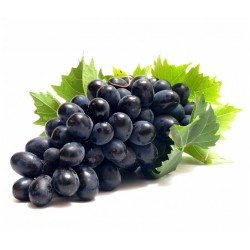
Black Grape Seeds (vitis...
السعر
1.95 €
SKU: V 131
Seeds Gallery Com,
5/
5
<h2><span style="text-decoration:underline;"><strong><em>BLACK GRAPE SEEDS (VITIS VINIFERA)</em></strong></span></h2>
<h3><span style="color:#ff0000;"><strong>Price for Package of 10 seeds.</strong></span></h3>
<p>A grape is a fruiting berry of the deciduous woody vines of the botanical genus Vitis. Grapes can be eaten raw or they can be used for making wine, jam, juice, jelly, grape seed extract, raisins, vinegar, and grape seed oil. Grapes are a non-climacteric type of fruit, generally occurring in clusters.</p>
<p> </p>
<p><strong>Description</strong></p>
<p>Grapes are a type of fruit that grow in clusters of 15 to 300, and can be crimson, black, dark blue, yellow, green, orange and pink. "White" grapes are actually green in color, and are evolutionarily derived from the purple grape. Mutations in two regulatory genes of white grapes turn off production of anthocyanins, which are responsible for the color of purple grapes. Anthocyanins and other pigment chemicals of the larger family of polyphenols in purple grapes are responsible for the varying shades of purple in red wines. Grapes are typically an ellipsoid shape resembling a prolate spheroid.</p>
<p> </p>
<p><strong>History</strong></p>
<p>The cultivation of the domesticated grape began 6,000–8,000 years ago in the Near East. The earliest archeological evidence for a dominant position of wine-making in human culture dates from 8,000 years ago in Georgia.</p>
<p>Yeast, one of the earliest domesticated microorganisms, occurs naturally on the skins of grapes, leading to the innovation of alcoholic drinks such as wine. The earliest known production occurred around 8,000 years ago on the territory of Georgia. During an extensive gene-mapping project, archaeologists analyzed the heritage of more than 110 modern grape cultivars, and narrowed their origin to a region in Georgia, where wine residues were also discovered on the inner surfaces of 8,000-year-old ceramic storage jars. The oldest winery was found in Armenia, dating to around 4000 BC. By the 9th century AD the city of Shiraz was known to produce some of the finest wines in the Middle East. Thus it has been proposed that Syrah red wine is named after Shiraz, a city in Persia where the grape was used to make Shirazi wine. Ancient Egyptian hieroglyphics record the cultivation of purple grapes, and history attests to the ancient Greeks, Phoenicians and Romans growing purple grapes for both eating and wine production. The growing of grapes would later spread to other regions in Europe, as well as North Africa, and eventually in North America.</p>
<p> </p>
<p>In North America, native grapes belonging to various species of the Vitis genus proliferate in the wild across the continent, and were a part of the diet of many Native Americans, but were considered by European colonists to be unsuitable for wine. Vitis vinifera cultivars were imported for that purpose.</p>
<p> </p>
<p><strong>Distribution and production</strong></p>
<p>According to the Food and Agriculture Organization (FAO), 75,866 square kilometers of the world are dedicated to grapes. Approximately 71% of world grape production is used for wine, 27% as fresh fruit, and 2% as dried fruit. A portion of grape production goes to producing grape juice to be reconstituted for fruits canned "with no added sugar" and "100% natural". The area dedicated to vineyards is increasing by about 2% per year.</p>
<p> </p>
<p>There are no reliable statistics that break down grape production by variety. It is believed that the most widely planted variety is Sultana, also known as Thompson Seedless, with at least 3,600 km2. (880,000 acres) dedicated to it. The second most common variety is Airén. Other popular varieties include Cabernet Sauvignon, Sauvignon blanc, Cabernet Franc, Merlot, Grenache, Tempranillo, Riesling and Chardonnay.</p>
<p> </p>
<p><strong>Juice</strong></p>
<p>Grape juice is obtained from crushing and blending grapes into a liquid. The juice is often sold in stores or fermented and made into wine, brandy or vinegar. In the wine industry, grape juice that contains 7–23% of pulp, skins, stems and seeds is often referred to as "must". In North America, the most common grape juice is purple and made from Concord grapes while white grape juice is commonly made from Niagara grapes, both of which are varieties of native American grapes, a different species from European wine grapes. In California, Sultana (known there as Thompson Seedless) grapes are sometimes diverted from the raisin or table market to produce white juice.</p>
<p> </p>
<p><strong><em>Health claims</em></strong></p>
<p><strong>French paradox</strong></p>
<p>Comparing diets among Western countries, researchers have discovered that although the French tend to eat higher levels of animal fat, the incidence of heart disease remains low in France. This phenomenon has been termed the French paradox, and is thought to occur from protective benefits of regularly consuming red wine. Apart from potential benefits of alcohol itself, including reduced platelet aggregation and vasodilation, polyphenols (e.g., resveratrol) mainly in the grape skin provide other suspected health benefits, such as:</p>
<p> </p>
<p> Alteration of molecular mechanisms in blood vessels, reducing susceptibility to vascular damage</p>
<p> Decreased activity of angiotensin, a systemic hormone causing blood vessel constriction that would elevate blood pressure</p>
<p> Increased production of the vasodilator hormone, nitric oxide (endothelium-derived relaxing factor)</p>
<p> </p>
<p>Although adoption of wine consumption is not recommended by some health authorities, a significant volume of research indicates moderate consumption, such as one glass of red wine a day for women and two for men, may confer health benefits. Emerging evidence is that wine polyphenols like resveratrol provide physiological benefit whereas alcohol itself may have protective effects on the cardiovascular system. More may be seen in the article the Long-term effects of alcohol.</p>
<p> </p>
<p><strong>Resveratrol</strong></p>
<p>Synthesized by many plants, resveratrol apparently serves antifungal and other defensive properties. Dietary resveratrol has been shown to modulate the metabolism of lipids and to inhibit oxidation of low-density lipoproteins and aggregation of platelets.</p>
<p> </p>
<p>Resveratrol is found in widely varying amounts among grape varieties, primarily in their skins and seeds, which, in muscadine grapes, have about one hundred times higher concentration than pulp. Fresh grape skin contains about 50 to 100 micrograms of resveratrol per gram.</p>
<p> </p>
<p>In vitro studies indicate that protection of the genome through antioxidant actions may be a general function of resveratrol. In laboratory studies with mice, resveratrol has transcriptional overlap with the beneficial effects of calorie restriction in heart, skeletal muscle and brain. Both dietary interventions inhibit gene expression associated with heart and skeletal muscle aging, and prevent age-related heart failure.</p>
<p> </p>
<p>Resveratrol is the subject of several human clinical trials, among which the most advanced is a one year dietary regimen in a Phase III study of elderly patients with Alzheimer's disease.</p>
<p> </p>
<p><strong>Anthocyanins and other phenolics</strong></p>
<p>Anthocyanins tend to be the main polyphenolics in purple grapes whereas flavan-3-ols (i.e. catechins) are the more abundant phenolic in white varieties.[31] Total phenolic content, a laboratory index of antioxidant strength, is higher in purple varieties due almost entirely to anthocyanin density in purple grape skin compared to absence of anthocyanins in white grape skin.[31] It is these anthocyanins that are attracting the efforts of scientists to define their properties for human health.[32] Phenolic content of grape skin varies with cultivar, soil composition, climate, geographic origin, and cultivation practices or exposure to diseases, such as fungal infections.</p>
<p> </p>
<p>Red wine may offer health benefits more so than white because potentially beneficial compounds are present in grape skin, and only red wine is fermented with skins. The amount of fermentation time a wine spends in contact with grape skins is an important determinant of its resveratrol content.[33] Ordinary non-muscadine red wine contains between 0.2 and 5.8 mg/L,[34] depending on the grape variety, because it is fermented with the skins, allowing the wine to absorb the resveratrol. By contrast, a white wine contains lower phenolic contents because it is fermented after removal of skins.</p>
<p> </p>
<p>Wines produced from muscadine grapes may contain more than 40 mg/L, an exceptional phenolic content. In muscadine skins, ellagic acid, myricetin, quercetin, kaempferol, and trans-resveratrol are major phenolics. Contrary to previous results, ellagic acid and not resveratrol is the major phenolic in muscadine grapes.</p>
<p> </p>
<p>The flavonols syringetin, syringetin 3-O-galactoside, laricitrin and laricitrin 3-O-galactoside are also found in purple grape but absent in white grape.</p>
<p> </p>
<p><strong>Seed constituents</strong></p>
<p>Main articles: Grape seed extract and Grape seed oil</p>
<p>Biochemical and preliminary clinical studies have demonstrated potential biological properties of grape seed oligomeric procyanidins. For example, laboratory tests indicated a potential anticancer effect from grape seed extract. According to the American Cancer Society, "there is very little reliable scientific evidence available at this time that drinking red wine, eating grapes, or following the grape diet can prevent or treat cancer in people".</p>
<p> </p>
<p>Grape seed oil from crushed seeds is used in cosmeceuticals and skincare products for perceived health benefits. Grape seed oil contains tocopherols (vitamin E) and high contents of phytosterols and polyunsaturated fatty acids such as linoleic acid, oleic acid and alpha-linolenic acid.</p>
<p> </p>
<p><strong>Concord grape juice</strong></p>
<p>Commercial juice products from Concord grapes have been applied in medical research studies, showing potential benefits against the onset stage of cancer, platelet aggregation and other risk factors of atherosclerosis, loss of physical performance and mental acuity during aging and hypertension in humans.</p>
V 131 (10 S)





